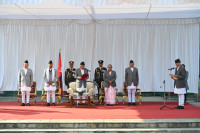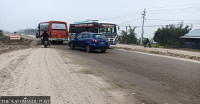National
NEA continues to delay purchase deals with run-of-the-river project developers
The Cabinet in June decided to ask the utility to sign PPAs with developers of hydropower projects up to 1500MW.
Prithvi Man Shrestha
Nepal Electricity Authority has shown no urgency to implement the Cabinet decision that ordered it to sign fresh power purchase agreements with the developers of the run-of-the-river type hydropower projects.
A Cabinet meeting in June had decided to open the door for signing of the PPA for 1,500MW of energy between the state-owned power utility and power developers amid constant pressure from the private sector developers.
The utility has stopped signing PPAs with the developers of the run-of-the-river type projects for the last three years citing the limited demand for power domestically in the wet season when such projects run on their full capacity.
The NEA has received PPA applications for more than 11,391 megawatts of electricity so far and the private sector has been demanding that the NEA start signing the agreements.
Kul Man Ghising, managing director of the NEA, told the Post that a proposal on signing the PPA with run-of-the-river type projects is under consideration at the NEA board. "We will make a decision on the matter soon," he said.
The NEA has been reluctant to sign PPA under take-or-pay modality with the run-of-the-river type projects which produce electricity in their full capacity in the monsoon and the NEA is not sure about whether the purchased power would be consumed in the wet season (May to November) domestically.
But the Indian market has also opened for Nepal to sell electricity through competitive bidding. New Delhi has allowed Nepal to sell 364MW power through the India Energy Exchange Limited, a trading platform.
Ghising told the Post that Nepal still faces the risk of spilling about 200 megawatts of electricity during the Dashain festival because of the low demand for power owing to the closure of industries.
Given this context, NEA wants to be sure first about whether electricity to be bought from the new run-of-the-river type projects would find consumers.
“As the NEA has to bear the liability by agreeing to purchase power under take-or-pay modality, it will first assess the prospect of electricity consumption,” said Sushil Chandra Tiwari, secretary at the Ministry of Energy, Water Resources and Irrigation. “The NEA will prepare a plan on how to use the electricity generated from more run-of-the-river type projects and make decisions regarding the signing of fresh PPAs.”
Tiwari, who is also a board member at the utility, said that the government move to allow the private sector to engage in electricity trade by issuing an ordinance was also aimed at giving more options to the power developers to sell their electricity.
The Cabinet has forwarded an ordinance to the President’s office for approval to let the private sector engage in power trade. The NEA’s reluctance to sign the PPA with a run-of-the-river type project looks contrary to the government’s plan to allow such projects to optimise their capacity so that they could produce more energy during the wet season.
The government is mulling over relaxing an existing provision that requires hydropower developers to design their projects in a way so as to produce electricity in full capacity for at least 4.8 months.
A hydropower project that can produce electricity in full capacity for 4.8 months is also known as Q40 project. Relaxation of this requirement means hydropower projects can optimise their installed capacity to produce more power in the summer when water levels rise in the rivers.
The Q40 provision was made in the Directive on Licensing Electricity Projects-2075 to prevent hydropower developers from optimising project capacities to their maximum, which could lead to the spilling of electricity generated in the wet season. In Nepal, the demand for electricity falls in the wet season and rises during the dry season.
As per the Directive on Licensing Electricity Projects-2075, the hydropower plants that apply for survey licence need to be designed on the basis of Q45 (flow exceedance).
“We charge a licence fee based on Q45 initially,” Akash Shrestha, a senior divisional engineer at the department, told the Post in early August. “We have, however, been accepting Q40 projects too based on the study of the project and signing of power purchase agreement with the Nepal Electricity Authority.”
Ashish Garg, vice-president of Independent Power Producers’ Association, said the government’s contradictory policy on run-of-the-river type projects confused the private sector power developers.
“On the one hand, the government has decided to ask the NEA to sign a PPA for 1,500MW power produced by run-of-the-river type projects and to relax the Q40 provision,” said Garg. “On the other hand, the NEA continues to delay the implementation of the Cabinet decision on the signing of PPAs.”




 17.12°C Kathmandu
17.12°C Kathmandu















